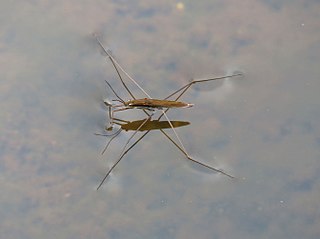180,000 species of Lepidoptera are described, equivalent to 10% of the total described species of living organisms. This is a list of the diversity of the Lepidoptera showing the estimated number of genera and species described for each superfamily and, where available, family. See Lepidoptera for a note of the schedule of families used.

Riodinidae is the family of metalmark butterflies. The common name "metalmarks" refers to the small, metallic-looking spots commonly found on their wings. The 1,532 species are placed in 146 genera. Although mostly Neotropical in distribution, the family is also represented both in the Nearctic, Palearctic, Australasian (Dicallaneura), Afrotropic, and Indomalayan realms.

Lophocoronoidea is a superfamily of insects in the order Lepidoptera. There is a single extant genus, Lophocorona, in the family Lophocoronidae. These are small, primitive nocturnal moths restricted to Australia whose biology is largely unknown.

Mimallonidae Burmeister (mimallonids), sometimes known as "sack-bearer" moths for the larval case-building behavior, are a family of Lepidoptera containing over 300 named species in 43 genera. These moths are found only in the New World, with most taxa occurring in the Neotropics. Adult moths are externally similar to those belonging to some of the other Macroheterocera families Bombycoidea and Drepanoidea, and thus have been variously treated as belonging to either one of these or other superfamilies.

Gracillariidae is an important family of insects in the order Lepidoptera and the principal family of leaf miners that includes several economic, horticultural or recently invasive pest species such as the horse-chestnut leaf miner, Cameraria ohridella.

The Adelidae or fairy longhorn moths are a family of monotrysian moths in the lepidopteran infraorder Heteroneura. The family was first described by Charles Théophile Bruand d'Uzelle in 1851. Most species have at least partially metallic, patterned coloration and are diurnal, sometimes swarming around the tips of branches with an undulating flight. Others are crepuscular and have a drab coloration. Fairy longhorn moths have a wingspan of 4–28 millimeters, and males often have especially long antennae, 1–3 times as long as the forewing.

Urodidae, whose species are commonly known as false burnet moths, is a family of moths in the lepidopteran order. It is the type genus in the superfamily, Urodoidea, with three genera, one of which, Wockia, occurs in Europe.

Pterolonchidae is a small family of very small moths in the superfamily Gelechioidea. There are species native to every continent except Australia and Antarctica.

Lepicerus is a genus of myxophagan beetles containing three described species in the family Lepiceridae; it is the only extant genus in the family, with another genus, Lepiceratus only known from fossils. Extant species occur in the Neotropics, from Mexico south to Venezuela and Ecuador. Fossils referrable to the genus are known from the early Late Cretaceous of Southeast Asia.
Latibulocrinis is a genus of moths belonging to the subfamily Tortricinae of the family Tortricidae. It contains only one species, Latibulocrinis curiosa, which is found in Brunei and Indonesia (Buru).
Williella is a genus of moths belonging to the subfamily Tortricinae of the family Tortricidae.
Polyvena is an extinct genus of moths belonging to the family Tortricidae. It contains only one species which was described from Dominican amber.

Elachista albidella is a moth of the family Elachistidae, described by William Nylander in 1848. Its wingspan ranges from 9–10 millimetres (0.35–0.39 in).The head is white. Forewings are white, costa and sometimes dorsum suffused with fuscous; plical stigma large, elongate, black ; an angulated fuscous fascia beyond middle, angle acutely produced towards apex ; small fuscous costal and dorsal spots near apex. Hindwings are rather dark grey.The larva is greenish-grey, more yellowish anteriorly; head dark brown.
Nemophora griseella is a moth of the Adelidae family or fairy longhorn moths. It was described by Lord Walsingham in 1880. It is found in India, Burma and Nepal.
Nemophora cassiterites is a moth of the Adelidae family or fairy longhorn moths. It was described by Edward Meyrick in 1907. It is found in India.
Nemophora chionites is a moth of the family Adelidae or fairy longhorn moths. It was described by Edward Meyrick in 1907. It is found in India and Thailand.
Macrosoma klagesi is moth-like butterfly described by Louis Beethoven Prout in 1916. It belongs to the family Hedylidae. Originally it belonged to the genus Phellinodes. Malcolm J. Scoble combined it with Macrosoma in 1986.
Marianne Horak is a Swiss-Australian entomologist who specialises in Australian Lepidoptera, particularly the phycitine and tortricid moths. She also did important research on the scribbly gum moths, during which eleven new species of Ogmograptis were discovered.

Limnoporus is a genus of water striders in the family Gerridae. There are six extant described species in Limnoporus.
Entephria bradorata is a species of geometrid moth in the family Geometridae. It is found in North America.










